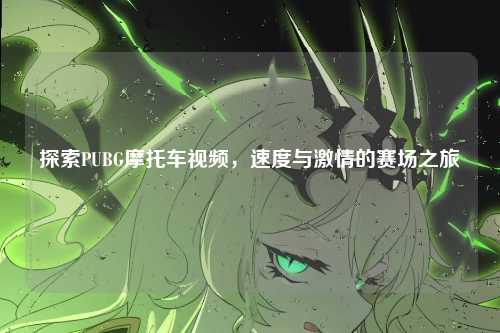探索PUBG摩托车视频,速度与激情的赛场之旅
在《绝地求生》(PUBG)这款风靡全球的战术竞技游戏中,摩托车一直是玩家们又爱又恨的交通工具,它以其无与伦比的速度,为玩家们在广袤的战场中带来了独特的体验,也因此催生了无数精彩绝伦的pubg摩托车视频,这些视频不仅展示了玩家们高超的驾驶技巧,更呈现了游戏中紧张刺激的战斗瞬间,让观众仿佛置身于激烈的战场之中。
PUBG摩托车的魅力
PUBG中的摩托车种类丰富,每一种都有着独特的性能特点,最常见的两轮摩托车,操控相对灵活,能快速穿梭于地形复杂的区域,无论是在山地还是林间小道,都能展现出其敏捷的身姿,它启动迅速,加速迅猛,能让玩家在短时间内获得极高的速度,瞬间拉开与敌人的距离。

而三轮摩托车则更具稳定性,虽然速度略逊于两轮摩托,但在经过颠簸路段或高速行驶时,能给玩家更好的驾驶体验,减少翻车的风险,特别是在组队作战时,它可以搭载一名队友,成为团队快速转移的得力工具。
摩托车的魅力不仅在于其速度,更在于它能为玩家带来一种自由驰骋的感觉,在游戏中,当玩家驾驶着摩托车在广阔的地图上飞驰时,周围的风景如电影画面般快速掠过,这种身临其境的速度感是其他交通工具所无法比拟的,摩托车也是玩家们出奇制胜的法宝,在关键时刻,驾驶摩托车突然出现在敌人意想不到的位置,常常能打乱敌人的部署,为自己或团队创造有利的战斗条件。
pubg摩托车视频中的精彩瞬间
在众多pubg摩托车视频中,有许多令人热血沸腾的精彩瞬间,比如一些玩家在激烈的战斗中,巧妙地利用摩托车的速度优势,迂回穿插于敌人之间,躲避敌人的枪林弹雨,同时寻找最佳的攻击时机,他们如同战场上的幽灵,驾驶着摩托车风驰电掣般靠近敌人,然后瞬间发动攻击,给予敌人致命一击,整个过程一气呵成,让人看得大呼过瘾。
还有一些玩家在复杂的地形中展示出了超凡的摩托车操控技巧,在狭窄的山路中,他们能精准地控制摩托车的方向和速度,以极小的空间完成漂移和转弯,仿佛摩托车成为了他们身体的延伸,在跨越障碍时,他们能凭借精湛的操作,让摩托车平稳飞跃,既避免了自己受到伤害,又为后续的行动争取了时间。
更有甚者,在团队协作的pubg摩托车视频中,玩家们配合默契,将摩托车的作用发挥到了极致,一名玩家驾驶摩托车吸引敌人的注意力,另一名玩家则趁机从侧面或后方发动突袭,这种战术配合让敌人防不胜防,在一场激烈的团战中,玩家们骑着摩托车如同一支支离弦之箭,冲向敌人的阵地,瞬间打破了敌人的防线,为团队赢得了胜利。
制作pubg摩托车视频的技巧与要点
要制作出吸引人的pubg摩托车视频,需要掌握一些技巧和要点,视频的拍摄角度至关重要,采用第一视角拍摄,可以让观众更直观地感受到玩家在驾驶摩托车时的紧张刺激,仿佛自己就是驾驶者,从摩托车的前方、后方、侧面等不同角度进行拍摄,能够全方位展示摩托车的行驶姿态和玩家的操作细节,增加视频的观赏性。
剪辑是决定视频质量的关键环节,合理运用剪辑技巧,如快切、慢放、转场等,可以突出摩托车行驶的速度感和战斗中的精彩瞬间,在摩托车加速冲刺时,可以使用快切镜头,营造出风驰电掣的效果;而在玩家做出高难度操作时,如精准漂移或者惊险飞跃,可以通过慢放镜头,让观众清晰地看到每一个细节,感受到玩家的高超技艺。
音效的添加也能为视频增色不少,摩托车发动机的轰鸣声、轮胎与地面的摩擦声、枪声以及玩家的呼喊声等,都能营造出逼真的战场氛围,合适的音效可以增强观众的代入感,让他们更加沉浸在视频所呈现的场景之中。
为视频添加一些特效和字幕也是不错的选择,特效可以用于突出某些关键画面,如摩托车飞跃时添加一些光影效果,使其更加震撼,字幕则可以用来解释一些精彩操作或者战斗策略,帮助观众更好地理解视频内容。
pubg摩托车视频对玩家的影响
pubg摩托车视频对玩家们产生了多方面的影响,对于新手玩家来说,这些视频是很好的学习资料,通过观看高手们的驾驶技巧和战斗策略,新手玩家可以快速了解摩托车在游戏中的应用方法,提高自己的游戏水平,他们可以从视频中学习如何在不同地形驾驶摩托车,如何利用摩托车进行战术转移和攻击,从而在实际游戏中少走弯路。
对于资深玩家而言,pubg摩托车视频则是一种娱乐和交流的方式,他们可以在视频中寻找共鸣,分享自己在游戏中驾驶摩托车的类似经历,这些视频也激发了他们进一步挑战自我的欲望,促使他们在游戏中尝试更多高难度的摩托车操作,创造出更加精彩的战斗瞬间。
pubg摩托车视频在网络上的广泛传播,也进一步提升了游戏的知名度和影响力,越来越多的人通过观看这些视频了解到PUBG这款游戏,被其中摩托车带来的激情体验所吸引,从而加入到游戏中来,这不仅为游戏开发商带来了更多的用户,也推动了整个游戏社区的发展。
pubg摩托车视频的未来发展趋势
随着PUBG游戏的不断更新和发展,pubg摩托车视频也将迎来新的变化和发展趋势,视频制作可能会更加注重创新和个性化,玩家们会尝试更多独特的拍摄手法和表现形式,以展现出与众不同的游戏视角和体验,采用虚拟现实(VR)技术进行拍摄,让观众能够身临其境地感受驾驶摩托车的乐趣,这将为视频带来全新的视觉冲击。
随着游戏中摩托车相关内容的不断丰富,如更多新的车型、新的地图场景适合摩托车行驶等,pubg摩托车视频的题材也将更加多样化,玩家们可以探索更多不同的玩法和策略,制作出更具深度和广度的视频作品。
可以预见的是,pubg摩托车视频将更加注重与观众的互动,视频创作者会积极与观众交流,了解他们的需求和喜好,根据观众的反馈来调整视频内容和制作方向,观众也将不再仅仅是被动的观看者,而是可以通过各种方式参与到视频的创作过程中,如提供创意、参与视频的评论和讨论等,形成一种更加活跃的创作与交流氛围。
pubg摩托车视频作为PUBG游戏文化的重要组成部分,以其独特的魅力吸引着无数玩家和观众,它不仅展示了游戏中的精彩瞬间,也促进了玩家之间的交流和学习,推动了游戏的传播和发展,相信在未来,pubg摩托车视频将继续蓬勃发展,为玩家们带来更多精彩和惊喜。


